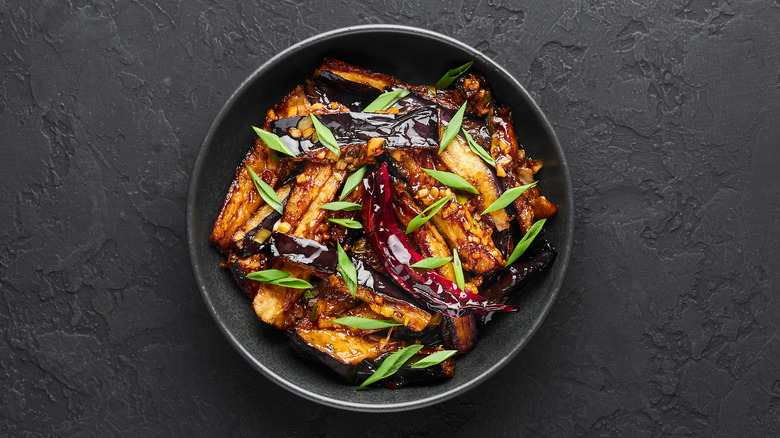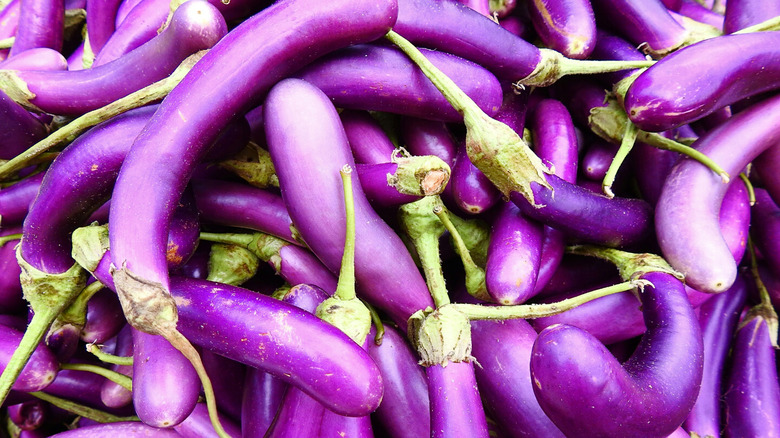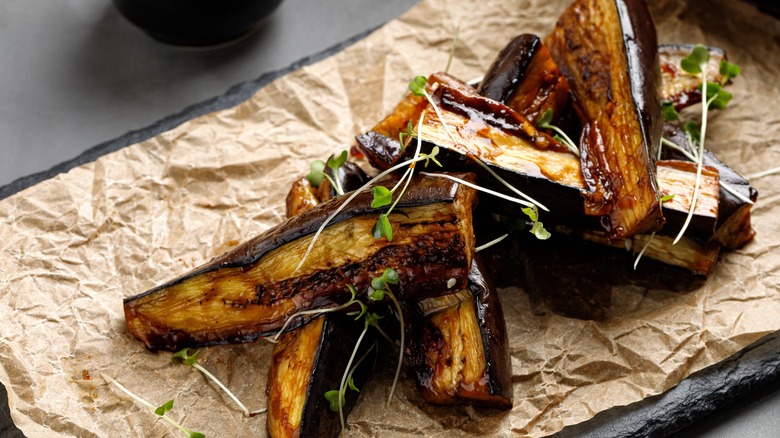What Are Chinese Eggplants (And What Makes Them So Versatile)?
Eggplants, also known as aubergines, sometimes get a bad rep. In fact, the purple fruit was once nicknamed "mad apple" by Europeans as eggplants were thought to be poisonous, per Permaculture News. That's because eggplants are part of the Nightshade family, which the toxic nightshade berries belong to (via Harvesting History). Even Americans avoided eggplants, as well as tomatoes and potatoes, because of their association with nightshades. Eggplants, however, were first cultivated and eaten in parts of Asia, such as China and India, for thousands of years.
Whether you call them eggplants, aubergines, or brinjal, the shiny orb-shaped fruit is packed with nutrients, per Healthline. They are a good source of fiber, vitamins, and minerals and are high in antioxidants.
Most people are familiar with globe eggplants, sometimes called the American eggplant. Globe eggplants are the typical purple, oblong fruit found at grocery stores. There are other varieties, such as Italian eggplant, Japanese eggplant, tiny Indian and Thai eggplant, and Chinese eggplant (via Made In). While Chinese eggplants look similar to globe eggplants, there are a few differences when it comes to prepping and cooking them.
What are Chinese eggplants?
Just as the name suggests, Chinese eggplants are native to China, but they are also cultivated in other parts of Asia (via Nature's Produce). Chinese eggplants are as purple as globe eggplants but have a few different characteristics. They are usually skinnier, longer, and have thin skins with a white interior. They are also seedless, which lends to their meaty texture, sweet flavor, and lack of bitterness.
While you can buy Chinese eggplants at practically any grocery store — especially Asian supermarkets — you can grow the plant yourself. Chinese eggplants, also known as Ping Tung or Ping Tung Long, are best grown during the summer (via The Woks of Life). The purple fruit thrives the best in warm soil and is vulnerable in weather below 55 degrees and over 95 degrees Fahrenheit. The prime temperature for growing Chinese eggplants is between 70 and 85 degrees.
Chinese eggplants love sun and water, so make sure that the fruits get both. The eggplant takes about 50 to 65 days to grow; you will know it's ripe for picking when the skin is smooth and shiny. If it is yellow, it's a clear-cut indicator that it's not good to eat. If you can get your hands on Chinese eggplants, there seem to be endless ways to cook them.
How to cook Chinese eggplants
It seems like Chinese eggplants can do it all. While globe eggplants are only suited for grilling and roasting and use in stews, Made With Lau explains that Chinese eggplants can be used for stir-frying, sautéing, and braising.
According to Science of Cooking, eggplants should be salted to reduce moisture and bitterness. However, due to their naturally sweet flavor, you don't need to do that with Chinese eggplants. Eggplants are known to absorb flavors, sometimes even becoming too oily from absorbing the oil they're cooked in. While you don't need to salt Chinese eggplants, if you choose to do so to prevent the eggplant from absorbing oil, Cook's Illustrated recommends microwaving the eggplant after salting it to accelerate the process.
Chinese eggplants can be incorporated or swapped into nearly any traditional Chinese fare, such as the classic Sichuan dish, eggplants with garlic sauce (via Made With Lau). Not sure what to cook? A simple chicken or tofu stir-fry with Chinese eggplants added to the mix can brighten up your plate. Chili crisps containing Sichuan peppers are also a good way to infuse spice into your eggplant dish.


